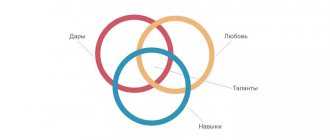Character is formed gradually. But the foundation for the formation of character is, indeed, laid from birth and even earlier - from the womb. After all, what is character? These are behavioral habits. A child is like dough: as you knead it, it grows. A child's defects are not born, but nurtured. Character is formed during the first three years of life. Already at the age of three, a child’s behavior largely determines his character in the future. This idea was confirmed by a long-term study, the results of which were recently published. In 1975-1976, scientists at the Institute of Psychiatry in London rated the behavior of 1,000 three-year-old children as “well-adjusted,” “uncontrollable,” “confident,” “inhibited,” or “restrained.”
What parents accept as character at the very beginning of a child’s life is a manifestation of the quality of functioning of the child’s body as a whole, and his nervous system in particular. Let's say a child suffers from colic. How then does the child manifest himself? He is loud and whiny. Also, if a child has increased tone, it is difficult for him to fall asleep. There are “demanding” children who cannot be put to bed. Such children need to be rocked or carried “in a column” all the time, as parents say. Such children are restless and capricious. This is a manifestation of poor venous outflow from the brain, an indicator that the cervical vertebrae are pinching blood vessels.
When lying down, blood rushes to the head, causing headaches, tinnitus, and increased intracranial pressure. Only in an upright position does the child feel relief. But the quiet child is the golden child. And the neurologist says that his muscle tone is reduced. What will it be like in the future? Lethargic, frail, apathetic, inert. Will develop slowly physically. He will be exhausted, it will be difficult for him to endure the training load.
Character? No!
When speaking of “the character of a child,” it is necessary to take into account the stages of development of the brain and nervous system. The first stage of “character” development is intrauterine. It is in the womb that the first part of the brain, the brain stem, begins to work. It rises from the spinal cord, and on it, like on the stem of a mushroom, rests the cap - the cerebral cortex. The brain stem is responsible for all life maintenance processes. The trunk is also called the reptilian brain, because reptiles are limited in their development on it. And this department gives us the following manifestations: a feeling of pleasure - displeasure, I want - I don’t want, laziness, fear, anger, aggression and stubbornness.
The crocodile has a very complex character. He lazily, due to lack of energy, lies in the sun and enjoys himself. But try to “tread on his tail,” and you will see stubbornness, aggression (the other side of fear). By the age of 1, the limbic system comes into play and introduces its own characteristics. This is symbiosis with the mother (attachment, which should decrease by the age of 3-5), attachment to the territory (hence the fear of new places), emotional mobility (frequent mood changes). And also a capricious character, with fears of novelty and poor social adaptation.
Mentality, qualities of a Russian person
Mentality is a very subjective concept, and it is based on stereotypical thinking. However, it cannot be denied that certain traits are inherent in one or another nationality. Russian people are famous for their cordiality and hospitality, and cheerful disposition. The Russian soul throughout the world is considered mysterious and incomprehensible, since Russians are not distinguished by the rationality and logic of their actions, and are often influenced by mood. Another feature of the Russian people is sentimentality. A Russian person instantly adopts the feelings of another and is always ready to share emotions with him and lend a helping hand. It is impossible not to mention another trait - compassion. Historically, Russia has helped its neighbors at all borders of the country, and today only a heartless person will ignore the misfortune of another.
Where does the complex character of a child come from?
- If the pregnancy was difficult and was accompanied by toxicosis, edema, anemia, illness, threat of miscarriage, stress; The character of the child. How to understand your child
- Or the birth was rapid or prolonged (with cesarean section, umbilical cord entanglement, hypoxia, birth trauma);
- Or the child has torticollis, tremor, increased or decreased tone, PEP, MMD, movement disorder syndrome.
In such cases, behavioral manifestations dictated by the reptilian brain and limbic system can take over. That is, you will constantly encounter them, they will become a habit. And character traits are a set of habits. Why? Because the brain, due to all of the above, “freezes” at this level of functioning. This “freezing” determines the child’s psychological development. “Stubbornness does not come from character, but from history” (Medical history of child development). In this case, the child may have high intelligence, but the cerebral cortex cannot cope with the management of the subcortex (brain stem and limbic system).
When development proceeds correctly, the cerebral cortex (namely the forehead) takes on the function of controlling the “pranks” of the subcortex. An important condition for this will be the timely and high-quality development of speech. Self-control over behavior and emotions is carried out using inner speech. Of course, there are inherited character traits. This is when they say “Dad is the same.” But you need to ask your grandmother how things were with dad in infancy?
Demonstrativeness
- tries by any means to draw the attention of others to himself, including by breaking the rules;
- makes faces, distorts and emphasizes the movements or behavior of others (it is important to distinguish from copying, which the child does in order to learn something);
- evaluates the reaction of others to his behavior, especially adults;
- strives to receive a positive assessment in any way;
- shows new toys, unusual objects not to play with them, but to show off;
- compares himself with other children, while always emphasizing his own merits;
- tries to identify the shortcomings of peers, gives a negative assessment of the actions or results of other children; the pronoun “I” predominates in speech;
- reacts painfully if an adult praises another child.
Adults need to save the child from the need to prove his advantage and assert himself. He should feel love and respect, which does not necessarily need to be fueled by his superiority over others. This can be achieved by showing sincere interest in the child.
In relationships with peers, you should avoid competitive games, fights, and competitions. The child should focus on cooperation and partnership. It is important to switch children’s attention to the process and exclude evaluation of the results of the task. Any games (role-playing, round dancing) are suitable, where all the children interact, there is a sense of community and cohesion, and no one stands out.
Good news: Character changes!
BBC Future columnist Christian Jarrett argues that a person's character and temperament are revealed in early childhood - even before a child begins to speak. Your personality is shaped by many factors. Genetic inheritance, friends, school and many other factors play a role in the development of personality. But at what age is a person’s character formed and does it change over the years? If, for example, you are shy now, does that mean you were shy as a child?
In all likelihood, yes. Research shows that already in the first months of a baby’s life, signs of his future personality are present in his behavior. This does not mean, of course, that our character remains completely unchanged, but its main features begin to appear almost immediately. One of the most long-term studies in this area, which began in the 1950s, was conducted by New York psychologists Alexander Thomas and Stella Chess. Based on the experience of testing large groups of children of different ages, they proposed to identify 9 fundamental aspects of temperament, which make it possible to most fully characterize a set of behavioral characteristics, such as activity, mood and distractibility.
Scientists also established a certain pattern between various aspects of behavior and divided all children into three groups: “light”, “heavy” and “slow” (in those days they did not yet know about political correctness). Do these childhood characteristics correspond to the adult personality type? Chess and Thomas's study found that participants who were classified as either "light" or "heavy" in childhood were classified as "light" or "heavy" in adolescence. Scientists, however, have not studied the connection between a child’s temperament and the basic personality traits of an adult.
In fact, psychologists have only recently begun to question the relationship between child character and adult personality. Despite the fact that a child’s temperament does not shape an adult’s personality 100 percent, there is certainly a connection between them. Of course, over time, the methodology for assessing a child’s temperament has changed noticeably. Today, the original nine aspects of temperament have been reduced to three general categories. Different schools of psychology use different terminology, but in general they boil down to the following aspects.
List of positive human qualities
The list of positive and negative qualities of a person is huge. Initially, all definitions regarding the nature and essence of a person, his behavior are subjective. Society has established certain norms that allow us to determine how positive or negative a particular personality trait or action is. However, there are the highest qualities of a person that demonstrate his virtue and good intentions. Their list looks like this:
- altruism;
- reverence for elders;
- kindness;
- fulfillment of promises;
- moral;
- responsibility;
- loyalty;
- perseverance;
- moderation;
- responsiveness;
- honesty;
- sincerity;
- selflessness and others.
These qualities, along with their derivatives, constitute the nature of the true beauty of a person's character. They are laid down in the family; in the process of upbringing, children copy the behavior of their parents, and therefore a well-educated person will have all these highest qualities.
If you call yourself an extrovert, get into the “gifted group.”
In the 1950s, scientists classified children as “difficult,” “easy,” and “slow.” “Conscious control,” which measures a child’s ability to exert self-control and concentration (for example, the ability to resist the temptation of a beautiful toy), “negative emotions,” which measures how often a child experiences fear and frustration, and “extroversion,” which relates to the child’s level of activity. his ability to make friends. In a study conducted by Russian scientists, 45 parents were asked to rate their children's temperament in these three categories at seven months of age, and then on the basic dimensions of adult personality - extraversion and neuroticism - at eight years.
A comparison of the survey results revealed certain patterns. Extroverted children aged eight tended to show lower levels of neuroticism (that is, they were more emotionally stable). And children who received the highest score in the “conscious control” category had high levels of conscientiousness as adults. So, if your baby demonstrates a remarkable level of attention, he will obviously be neat as a teenager.
Anxiety
- Physical manifestations (not related to illness, poor diet, weather, etc.): muscle tension, fever or chills, dizziness, numbness, tingling, trembling, tightness in the chest or abdomen, cold and clammy hands, sleep disturbance.
- Behavior:
- gets tired quickly;
- cannot concentrate for a long time;
- shudders, is frightened by ordinary objects, has many fears;
- avoids difficulties, refuses complex tasks and new activities;
- prefers to be closer to adults, wants to sleep with parents (or other adult relatives)
- speaks quietly, often stammers;
- looks distantly around, with a wandering gaze;
- remembers poorly, asks again;
- strives to protect himself and receive protection, does not show independence in games;
- moves stiffly, slowly and carefully (if this has not been previously noticed and is not related to temperament);
- cries, is capricious, offended, sad for no apparent reason;
- shows uncertainty and indecisiveness.
In general, the task of parents is to restore the child’s trust in the world and others and eliminate fears. To do this, it is necessary to celebrate even minor successes, any positive results of his work. It is advisable to increase the number of contacts with other children. For example, while organizing holidays at home, you should not leave an anxious child alone with the guests. He may feel danger without seeing close people nearby.
Requirements from all family members should be clear, consistent, and not too strict. Anxiety and shyness can be combined; many of the manifestations of these behavioral characteristics are similar, as are the tips for parents.
You cannot threaten a child with unrealistic punishments (“I will give you to the gray wolf”, “I will kill you”, “instead of you we will take another boy who will obey”). It is extremely undesirable to use derogatory expressions, force competition, demand courage and dexterity, or compare with other children.
Negative personality traits of a child can be corrected, but this task is not an easy one. It will take time. Parents must take into account many factors that influence the development of their children's character. A specialist will help you take into account all the nuances and build the correct line of behavior for adults and children.
Fortune telling on the character of children
Those who were extroverted as children tend to exhibit lower levels of neuroticism as adults. However, this relationship is not always present. So, a smiling and friendly child will not necessarily grow into an extrovert. Therefore, our character in early childhood is not 100 percent a life vector. At the same time, this study provides additional evidence that character traits that emerge in the first year of life form the basis for later personality development.
Surprisingly, temperamental traits discovered in early childhood usually persist into adulthood. This conclusion was reached by Czech researchers who compared the results of personality assessment at the age of 1-2.5 years and 40 years. However, it is worth remembering that, despite some similarities between the character of a child and an adult, our personality is constantly developing throughout life.
Many parents try to determine the future character of a child by his behavior in the first years of life. When personality tests were conducted with these same people at the age of 26, all indicators remained almost the same. For almost three decades, character traits have remained virtually unchanged. For example, “confident” children in adulthood demonstrated a much higher level of extraversion than “inhibited” children.
Scientists are increasingly convinced that the psychological problems of adults can be traced in the behavior of children at an early age. By learning to recognize their signs as early as possible, we could certainly make people's lives healthier and happier. A child's brain is plastic. Of course, this is not done by scolding and spanking. By doing this, you will also develop certain habits and character traits.
How can parents cultivate “good character”?
Excellent character includes an instinctive desire to care for oneself and others. It may be an experience, not a philosophy of life. Parenting absolutely influences the development of children's character! Here are four important life skills your child needs to develop:
- Show compassion
- Be able to compromise and negotiate
- Take responsibility for your actions
- Express your feelings and desires with words rather than impulsive behavior.
These simple rules will play an important role in shaping your child's character. Your relationship with your child is as unique and special as your relationship with your spouse or best friend. Like any long-term relationship, it can have its ups and downs. There is a belief that parenting is the only “job” that involves no formal training, very little background knowledge, and the “result” is about the people we value most—our children). We at Almamat believe that raising children cannot be equated with work. Just to get through the difficult periods of motherhood and fatherhood, you will need the “help of the whole village.”
The horrors of twos, anxious children and destructive teenagers would be enough to destroy us all without the help of other mothers, teachers, pediatricians and psychologists to remind us that we will survive. This is where our blog comes in: We collect data for parents from mommy blogs, scientific studies, educational surveys and even international surveys. These are parenting themes and stories to make you laugh, think, and help you get inspired, learn, and grow as a parent. And most importantly, data and methods to become the best parents you can be. Subscribe to our blog and receive “cheat sheets” for all occasions every week!
Shyness
- avoids public speaking and oral questioning;
- refuses to become a leader;
- does not answer the question, although he knows the correct answer;
- often uses the phrases “I don’t know”, “it’s hard to say”;
- cannot quickly decide to do something, doubts, is embarrassed;
- prefers to remain on the sidelines and does not stand out from the group of children;
- does not ask for help, even if it is necessary or takes a long time to decide to ask for it, while experiencing strong excitement and tension;
- generally shows lack of self-confidence and has low self-esteem;
- stops its activities and communication in case of poor results.
Parents need to increase their child's self-esteem. You cannot only point out shortcomings and defeats; you should emphasize your strengths, celebrate your successes, and praise. It is important to teach shy children how to properly express and control their feelings.
Mistakes and failures need to be calmly discussed and the reasons for the failures identified together with the child in a friendly environment. Establish trusting relationships among all family members, avoid quarrels, shouting, and a tense atmosphere in the house. Shyness is often accompanied by stiffness and low physical activity, so the need for movement cannot be limited. Showing love, support and interest from loved ones will help the child overcome internal conflict.











